Background
The United States conquered New Mexico in 1846 in the Mexican-American War. In the Treaty of Guadalupe Hidalgo of 1848, New Mexico and southern Colorado became territories of the United States. The treaty guaranteed the property rights of residents, mostly Hispanic, of the newly-acquired land. Prior to the U.S. conquest, the Spanish and New Mexican governments had distributed large acreages to Mexican citizens in the form of land grants. The U.S. government would later list 282 Spanish and Mexican land grants in New Mexico and Colorado totaling in area 34,653,346 acres (14,023,712 ha) [2] (54,146 square miles), an area larger than the country of England and about the same size as the state of New York. However, the U.S. required that all land grants be "confirmed" (determined to be legal) and over the next 50 years in a series of decisions and court cases the U.S. government disallowed some of the grants and reduced the acreage of many grants. Most of the larger land grants were populated by Indian tribes and only sparsely populated, if at all, by Hispanic settlers.
In the Spanish and Mexican documentation, the acreage and boundaries of the land grants were often vague and record keeping erratic or non-existent. The Hispanic system of designating and describing land ownership was different than that of the Anglo, relying more on custom and actual usage of the land than precise legal descriptions. Typically, settlers on grants were allocated small plots of land for agriculture and residences but most grant land was designated as common land for the joint use of all the settlers and their descendants. [4] The genesis of the Santa Fe Ring was in the 1850s when lawyers in New Mexico (of which there were only a few) realized "that a fortune lay in the legal process of quieting [obtaining] title to the disputed Spanish and Mexican land grants. Or, if not that, in securing for themselves or clients control of these lands for the purpose of speculation." [5]
Hispanic claimants of land in the land grants often did not speak English and were suspicious of and unfamiliar with the American legal system -- so different from the Hispanic. Many of the claimants were poor and unable to pursue the lengthy and expensive legal process of getting a claim confirmed. Moreover, the Surveyors General appointed by the U.S. had little knowledge of Hispanic land practices and customs. "The situation was ripe for fraud." [4] [6] The results were "large grants owned by speculators were erroneously confirmed; other grants which should have been confirmed were not...[and]...some valid grants were confirmed, but to the wrong people." The Santa Fe Ring of lawyers and politicians, often in league with the Surveyors General, abused the adjudication system for their own benefit. [7]
Lincoln County War
Businessman and Union Army veteran Lawrence Murphy became a key figure in the ring during the 1860s, alongside his German-American partner Emil Fritz, forming "L.G. Murphy & Co." in 1866.
Murphy and Fritz were able to obtain false deeds to land, then sold that land, not actually owned by them, to newly arriving farmers and ranchers. When payments were missed, Murphy and Fritz would foreclose on the land, cattle, or crops. Within a very short time they were wealthy men. During that same period they acquired government contracts to supply beef and vegetables to Apache Native Americans living on the reservation, which they typically did not supply, at least not in the quantities called for in the contracts. However, as they were protected by their political contacts who also were tied into the ring, complaints by the Native Americans went with little notice or attention.
In 1869, Murphy hired James Dolan to work as a clerk for his company. Murphy's business, located in Lincoln, New Mexico, very quickly became the only supplier to local ranchers and farmers, with Murphy, Fritz, Dolan and businessman John H. Riley developing it into a monopoly. Owing to the absence of competition, they were able to charge high prices for their goods, angering many in the area. By 1877, with the backing of wealthy rancher John Chisum, rancher John Tunstall and businessman Alexander McSween opened rival businesses, enraging Murphy and Dolan. Murphy by this time was in the first stages of cancer, but remained involved in decisionmaking for his business.
He, Dolan and Riley hired the Jesse Evans Gang and the John Kinney Gang, both outlaw gangs of the time, to goad Tunstall into a fight. Both gangs began rustling Tunstall's cattle, and to counter them Tunstall hired numerous small-scale ranchers and cowboys as bodyguards. Former Murphy employee Dick Brewer served as Tunstall's foreman, with gunmen Doc Scurlock, Charlie Bowdre, and ranchers Frank Coe and George Coe rounding out the group. Frank McNab would also hire on, as would Billy the Kid and Ab Saunders.
This set the stage for what would become known as the Lincoln County War, sparked by the February 18, 1878 murder of Tunstall by Jesse Evans and members of his gang. The Tunstall faction formed the Lincoln County Regulators. On February 18, 1879, Evans murdered attorney Huston Chapman, who was representing Susan McSween's interests on behalf of her dead husband and the Regulators. By October 1878, Murphy had died from cancer. Subsequently James Dolan took active control of the Murphy-Dolan interests.
New Mexico Territorial Representative Juan Patron became an advocate for Susan McSween, becoming involved as opposition to the ring following the murders of two local Hispanic businessmen in Lincoln County. On April 9, 1884, Patron was shot and killed by cowboy Michael Maney in Puerto De Luna, after having received numerous threats owing to his opposition to the Santa Fe Ring. Maney was arrested, and stood trial represented by several prominent attorneys. The prosecutor in the case was Santa Fe Ring member Thomas B. Catron, and Maney was acquitted. Catron was tightly allied with Albert Fall who would be implicated in the Teapot Dome scandal.
According to legend the rerouting of U.S. Route 66 to avoid Santa Fe and instead pass through Albuquerque was done at the behest of Democratic Governor Arthur T. Hannett to punish the ring. [8]
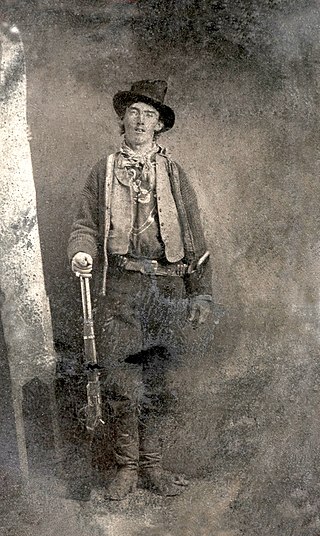
Henry McCarty, alias William H. Bonney, better known as Billy the Kid, was an American outlaw and gunfighter of the Old West who is alleged to have killed 21 men before he was shot and killed at the age of 21. He is also known for his involvement in New Mexico's Lincoln County War, during which he allegedly committed three murders.

The Lincoln County War was an Old West conflict between rival factions which began in 1878 in Lincoln County, New Mexico Territory, the predecessor of the state of New Mexico, and continued until 1881. The feud became famous because of the participation of William H. Bonney. Other notable participants included Sheriff William J. Brady, cattle rancher John Chisum, lawyer and businessmen Alexander McSween, James Dolan and Lawrence Murphy.

José Coby Frey Chávez y Chávez (1851–1924) was a Mexican-American outlaw from the New Mexican Territory, which is now the state of New Mexico, in the United States. He was said to be the son of a Spanish father and Apache mother. Chávez became an outlaw at a relatively young age when he joined the Lincoln County Regulators.
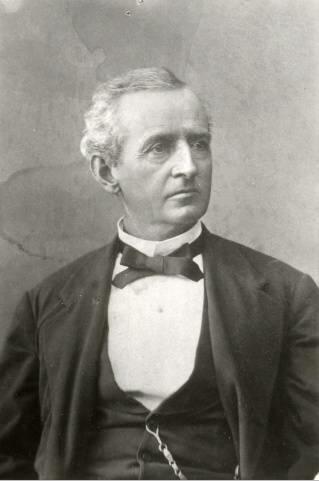
Samuel Beach Axtell was an American jurist and politician. He is noted for serving as chief justice of the New Mexico Territorial Supreme Court, territorial Governor of Utah and New Mexico, and a two-term Congressman from California.

Thomas Benton Catron was an American politician and lawyer who was influential in the establishment of the U.S. state of New Mexico, and served as one of its first United States Senators. Catron has defenders but enemies have described him as a "greedy land grabber and ruthless politico."
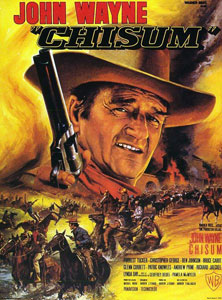
Chisum is a 1970 American Western film directed by Andrew McLaglen, starring John Wayne in the title role, and adapted for the screen by Andrew J. Fenady from his short story "Chisum and the Lincoln County War." The supporting cast features Forrest Tucker, Christopher George, Ben Johnson, Glenn Corbett, Andrew Prine, Bruce Cabot, Patric Knowles, Richard Jaeckel, Lynda Day George, Pedro Armendariz Jr., John Agar, John Mitchum, Ray Teal, Christopher Mitchum and Hank Worden with Geoffrey Deuel and Pamela McMyler receiving "introducing" credits. The picture was filmed in Panavision and Technicolor.

John Henry Tunstall was an English-born rancher and merchant in Lincoln County, New Mexico, United States. He competed with the Irish Catholic merchants, lawmen, and politicians who ran the town of Lincoln and the county. Tunstall, a member of the Republican Party, hoped to unseat the Irish and make a fortune as the county's new boss. He was the first man killed in the Lincoln County War, an economic and political conflict that resulted in armed warfare between rival gangs of cowboys and the ranchers, lawmen, and politicians who issued the orders.
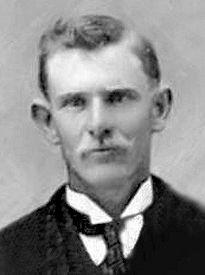
Josiah Gordon "Doc" Scurlock was an American Old West figure, cowboy, and gunfighter. A founding member of the Regulators during the Lincoln County War in New Mexico, Scurlock rode alongside such men as Billy the Kid.
The Lincoln County Regulators, or just the Regulators, were an American Old West deputized posse that fought in the Lincoln County War in New Mexico, during the late 19th century. They are well known for including Billy the Kid as a member.
The Jesse Evans Gang, also known as The Boys, was a gang of rustlers and robbers led by outlaw and gunman Jesse Evans, which lasted from 1876 until 1880. The gang was formed after Evans broke with the John Kinney Gang. After breaking away, he brought along with him Billy Morton, Frank Baker, Tom Hill, Dolly Graham, George Davis, Jim McDaniels, Buffalo Bill Spawn, Bob Martin, Manuel "Indian" Segovia and Nicholas Provencio.
George W. Hindman was a 19th-century American cowboy and law enforcement officer serving as a deputy sheriff of Lincoln County, New Mexico, during the early months of the Lincoln County War.
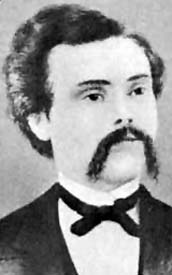
Alexander McSween was a prominent figure during the Lincoln County War of the Old West, and a central character, alongside John Tunstall, in opposing businessmen and gunmen Lawrence Murphy and James Dolan.
The Battle of Lincoln, New Mexico, was a five-day-long firefight between the Murphy-Dolan Faction and the Regulators that took place between July 15–19, 1878, in Lincoln, New Mexico. It was the largest armed battle of the Lincoln County War in the New Mexico Territory. The firefight was interrupted and suppressed by United States Cavalry led by Lt. Col. Nathan Dudley from Fort Stanton.

George Peppin was a corrupt sheriff in Lincoln County, New Mexico, who figured prominently into the Lincoln County War.
The Seven Rivers Warriors was an outlaw gang of the Old West known primarily due to its part in the Pecos War and the Lincoln County War.
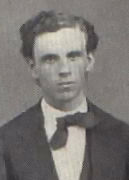
James Joseph Dolan was a Union Army veteran, Grand Army of the Republic member, Republican Party political boss, racketeer, Old West businessman and gunman, cattle baron, and a key figure in the Lincoln County War, in New Mexico, which launched Billy the Kid to fame.

Lawrence Gustave Murphy was an Irish immigrant to the United States, Union Army veteran, Grand Army of the Republic member, Democratic Party ward heeler, racketeer, Old West businessman and gunman, and a main instigator of the Lincoln County War.
Susan McSween was a prominent cattlewoman of the 19th century, once called the "Cattle Queen of New Mexico", and the widow of Alexander McSween, a leading factor in the Lincoln County War, who was shot and killed by members of the Murphy-Dolan faction.

Ab Saunders was an American cowboy, and at times gunman, best known for his association with Billy the Kid, Charlie Bowdre, Frank McNab, Doc Scurlock, and Saunders's cousins Frank and George Coe, when he was a member of the Lincoln County Regulators, a deputized posse, during the 1878 Lincoln County War in the New Mexico Territory

The Tierra Amarilla Land Grant in northern New Mexico and southern Colorado consists of 594,516 acres (2,405.92 km2) of mountainous land. It was awarded by the government of New Mexico to Manuel Martinez and his offspring in 1832. The grant was settled by Hispanics in the 1860s and the original inhabitants, the Ute Indians, were induced to leave. Settlers were given small plots, but most of the land in the grant area was designated as common land for the use of all the settlers and their descendants. After its conquest of New Mexico in 1846, the United States government upheld the validity of the grant, but subsequent actions by the U.S. did not protect the right to access common lands by the settlers. Politician and land speculator Thomas Catron, a member of the Santa Fe Ring, acquired nearly all the land by 1883 but later sold it to a development company. Access to the common lands of the grant by the Hispanic settlers and their descendants gradually disappeared as the common land became owned by Anglo ranchers, development companies, and speculators.













